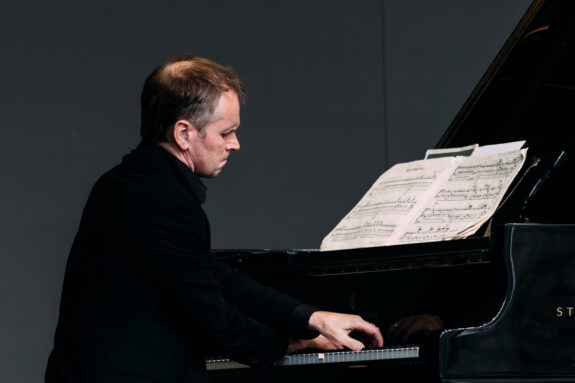 United Kingdom Bach, MacMillan, Weir and Schubert: Steven Osborne (piano). Wigmore Hall, London. 24.2.2025. (CSa)
United Kingdom Bach, MacMillan, Weir and Schubert: Steven Osborne (piano). Wigmore Hall, London. 24.2.2025. (CSa)

JS Bach – Jesu, Joy of Man’s Desiring
James MacMillan – Lumen Christi
Judith Weir – Chorale, for Steve
Schubert – Piano Sonata in B-flat (D.960)
It has been said that music can lift you up when you are down and give you courage when you are afraid. What better place of refuge than London’s Wigmore Hall, where, after a ceaseless four-week cycle of troubling news from the USA to Gaza, the great Scottish pianist Steven Osborne’s recent Bach and Schubert lunchtime recital provided some fortifying spiritual nourishment.
In a fitting start to his one-hour programme Osborne chose Dame Myra Hess’s famous solo piano transcription of Bach’s chorale Jesu, Joy of Man’s Desiring. Played softly and with sinuous grace and beauty, one’s thoughts inevitably turned to those morale-boosting performances of this work famously given by Dame Myra in her National Gallery recitals during the height of the Blitz.
The Bach was immediately followed by two deeply meditative short pieces. James MacMillan’s Lumen Christi, originally written as a choral work symbolizing the light of Christ dispelling darkness, and Chorale – a hymn-like composition written by Judith Weir and dedicated to the memory of Steven Stucky, the American composer and conductor known for his intricately textured compositions.
Having quickly established an atmosphere of reflective calm Osborne left the platform for two minutes and returned to play Schubert’s Sonata in B-flat D.960. ‘Who can do anything after Beethoven?’ the 31-year-old Schubert wrote to a friend. Yet, shortly before his final illness and just two months before his own premature death in 1828, Schubert composed a piece so expansive, introspective and lyrical, that it is rightly regarded as one of the most sublime works ever written for piano and certainly equal to the greatest of Beethoven’s chamber works. Perfectly proportioned and subtly coloured, Osborne’s seemingly effortless but highly dramatic account of the Sonata’s Molto moderato was characterised by a hushed serenity, disturbed only by distantly thunderous left-hand trills and mysterious shifts of key and mood. His slow and meticulously controlled build-up to the spacious climax and the return to the movement’s peaceful opening theme brilliantly captured the mixture of joy, melancholy and underlying anguish which features in all truly great performances of D.960.
The ghostly tranquillity of the first movement was heightened by Osborne in a haunting rendition of the Andante sostenuto. Its central theme, a mesmerising, gently rocking lullaby, was played with crystalline beauty. In a sudden change of mood, all remnants of dark skies and overhanging clouds were swept away in a flowing, joyful Scherzo, marked delicatezza. Osborne’s finely nuanced pianism ensured that Schubert’s irrepressible melody gleamed and bubbled like a sunlit stream. Launched by a single long-held note, the finale, a sparkling Allegro propelled us on a thrilling and ultimately triumphant journey. Osborne’s masterful playing was food for the soul, helping to remind in difficult times of music’s restorative power.
Chris Sallon
